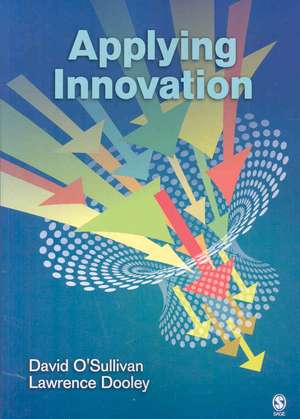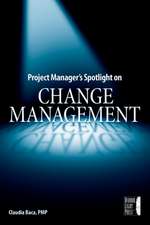Applying Innovation
Autor David O'Sullivan, Lawrence Dooleyen Limba Engleză Paperback – 18 aug 2008
Innovation is an important force in creating and sustaining organizational growth. Effective innovation can mean the difference between leading with a particular product, process, or service—and simply following the pack. Innovation transforms mediocre companies into world leaders and ordinary organizations into stimulating environments for employees.
Applying Innovation combines the key ingredients from areas including innovation management, strategic planning, performance measurement, creativity, project portfolio management, performance appraisal, knowledge management, and teams to offer an easily applied recipe for enterprise growth. Authors David O'Sullivan and Lawrence Dooley map out the main concepts of the innovation process into a clear, understandable framework—the innovation funnel.
Unlike other texts for this course, Applying Innovation goes beyond methodologies and checklists to offer an invaluable step-by-step approach to actually applying high-impact innovation in any organization using a knowledge management systems, whether for a boutique firm or one comprised of thousands of individuals.
Key Features:
- Adopts a practical approach to overseeing innovation that focuses on useful tools and techniques rather than on theory and methodologies
- Offers student activities within the text for immediate application of key concepts, reinforcing retention and comprehension
- Teaches students to build and apply effective innovation management systems for any organization successfully, regardless of the firm's size or structure
Applying Innovation is designed for undergraduate and graduate courses such as Innovation Management, Project Management, Strategic Planning, and Performance Management in fields of business, science, and engineering. This book appeals to instructors who want to reduce the "chalk and talk" and increase the hands-on practicality of their courses in innovation management.
| Toate formatele și edițiile | Preț | Express |
|---|---|---|
| Paperback (1) | 839.67 lei 6-8 săpt. | |
| SAGE Publications – 18 aug 2008 | 839.67 lei 6-8 săpt. | |
| Hardback (1) | 1205.49 lei 6-8 săpt. | |
| SAGE Publications – 3 sep 2008 | 1205.49 lei 6-8 săpt. |
Preț: 839.67 lei
Preț vechi: 1150.24 lei
-27% Nou
Puncte Express: 1260
Preț estimativ în valută:
160.68€ • 171.81$ • 133.96£
160.68€ • 171.81$ • 133.96£
Carte tipărită la comandă
Livrare economică 18 aprilie-02 mai
Preluare comenzi: 021 569.72.76
Specificații
ISBN-13: 9781412954556
ISBN-10: 141295455X
Pagini: 424
Dimensiuni: 178 x 254 x 24 mm
Greutate: 0.73 kg
Ediția:1
Editura: SAGE Publications
Colecția Sage Publications, Inc
Locul publicării:Thousand Oaks, United States
ISBN-10: 141295455X
Pagini: 424
Dimensiuni: 178 x 254 x 24 mm
Greutate: 0.73 kg
Ediția:1
Editura: SAGE Publications
Colecția Sage Publications, Inc
Locul publicării:Thousand Oaks, United States
Cuprins
Introduction
Book Aims
Book Structure
Learning Activities
Intended Audience
Acknowledgements
Part I. UNDERSTANDING INNOVATION
Learning Targets
Apple Makes Sweet Music
1. Defining Innovation
1.1. Introduction
Learning Targets
1.2. Definition of Innovation
1.3. Related Concepts
1.4. Drivers of Innovation
1.5. Categories of Innovation
1.6. Product Innovation
1.7. Process Innovation
1.8. Service Innovation
1.9. Product and Process Innovation
1.10. Radical and Incremental Innovation
1.11. Disruptive Innovation
1.12. Innovation and Operations
Case Study
Activities
1.13. Summary
Reflections
2. Managing Innovation
2.1. Introduction
Learning Targets
2.2. Techniques of Change
2.3. Change Methodology
2.4. Excellent Organizations
2.5. Innovation Culture
2.6. Barriers to Innovation
2.7. Adapting Culture
2.8. Models of Innovation
2.9. Managing Innovation
Case Study
Activities
2.10. Summary
Reflections
3. Processing Innovation
3.1. Introduction
Learning Targets
3.2. Investment in Innovation
3.3. Goals of Innovation
3.4. Failure of Innovation
3.5. Process of Innovation
3.6. Applied Innovation
3.7. Innovation Funnel
Case Study
Activities
Summary
Reflections
References
Part II. DEFINING INNOVATION GOALS
Learning Targets
4. Analyzing Environments
4.1. Introduction
Learning Targets
4.2. Goal Planning
4.3. Defining Goals
4.4. Environment Analysis
4.5. PEST Analysis
4.6. Five Force Model
4.7. Benchmarking
4.8. SWOT Analysis
4.9. Core Competencies
4.10. Developing Statements
Case Study
Activities
4.11. Summary
Reflections
5. Defining Objectives
5.1. Introduction
Learning Targets
5.2. Identifying Stakeholders
5.3. Defining Requirements
Case Study
Activities
5.4. Identifying Thrusts
5.5. Generic Market Objectives
5.6. Strategic Objectives
5.7. Objectives for Innovation
Case Study
Activities
5.8. Summary
Reflections
6. Measuring Indicators
6.1. Introduction
Learning Targets
6.2. Performance Indicators
6.3. Defining Indicators
6.4. Innovation Process Indicators
6.5. Performance Charts
6.6. Balanced Scorecard
6.7. Implementing the Balanced Scorecard
Case Study
Activities
6.8. Summary
Reflections
References
Part III. MANAGING INNOVATION ACTIONS
Learning Targets
3M and the Post-it Note
7. Creating Ideas
7.1. Introduction
Learning Targets
7.2. Action Pathway
7.3. Problem Solving
7.4. Creativity
7.5. Enhancing Creativity
7.6. Encouraging Creativity
7.7. Sources of Ideas
7.8. New Knowledge Ideas
Case Study
Activities
7.9. Ideation Tools
7.10. Selected Ideation Tools
7.11. Modeling Tools
7.12. Physical Space
Case Study
Activities
7.13. Summary
Reflections
8. Managing Projects
8.1. Introduction
Learning Targets
8.2. Projects
8.3. Project Planning
8.4. Project Scheduling
8.5. Project Controlling
8.6. Quantitative Benefits
8.7. Qualitative Benefits
8.8. Risk Management
8.9. Project Innovation
8.10. Project Tools
Case Study
Activities
8.11. Summary
Reflections
9. Developing Products
9.1. Introduction
Learning Targets
9.2. New Product Development
9.3. Stage Gate Process
9.4. Product Funding
9.5. Protecting New Products
9.6. Commercializing New Products
9.7. Linkages with Marketing
9.8. Diffusion of New Products
9.9. Entrepreneurship
Case Study
Activities
9.10. Summary
Reflections
10. Balancing Portfolios
10.1. Introduction
Learning Targets
10.2. Portfolio Objectives
10.3. Maximizing Value of Portfolio
10.4. Creating the right Mix of Projects
10.5. Maximizing Alignment with Goals
10.6. Optimizing Resources
10.7. Portfolio Budgeting
10.8. Balancing the Portfolio
Case Study
Activities
10.9. Summary
Reflections
References
Part IV. EMPOWERING INNOVATION TEAMS
Learning Targets
11. Leading Innovation
11.1. Introduction
Learning Targets
11.2. Transactional vs. Transformational
11.3. General Leadership Traits
11.4. Innovation Leadership Traits
11.5. Leadership Roles in Innovation
11.6. Leadership Interpersonal Skills
11.7. Leadership and Culture
11.8. Conflict Management
Case Study
Activities
11.9. Summary
Reflections
12. Building Teams
12.1. Introduction
Learning Targets
12.2. Organizational Structure
12.3. Aligning Structures
12.4. Defining Teams
12.5. Innovation Teams
12.6. Creating Effective Teams
12.7. Project Team Structure
12.8. Team Empowerment
12.9. Empowerment and Enablement
12.10. Team Skills
12.11. Virtual Teams
12.12. Communities of Practice
Case Study
Activities
12.13. Summary
Reflections
13. Motivating Performance
13.1. Introduction
Learning Targets
13.2. Motivation
13.3. Intrinsic and Extrinsic Motivation
13.4. Gain Sharing
13.5. Profit Sharing
13.6. Performance Appraisal
13.7. Performance Appraisal System
13.8. Training and Development
Case Study
Activities
13.9. Summary
Reflections
References
Part IV. EMPOWERING INNOVATION TEAMS
Learning Targets
14. Leading Innovation
14.1. Introduction
Learning Targets
14.2. Transactional vs. Transformational
14.3. General Leadership Traits
14.4. Innovation Leadership Traits
14.5. Leadership Roles in Innovation
14.6. Leadership Interpersonal Skills
14.7. Leadership and Culture
14.8. Conflict Management
Case Study
Activities
14.9. Summary
Reflections
15. Building Teams
15.1. Introduction
Learning Targets
15.2. Organizational Structure
15.3. Aligning Structures
15.4. Defining Teams
15.5. Innovation Teams
15.6. Creating Effective Teams
15.7. Project Team Structure
15.8. Team Empowerment
15.9. Empowerment and Enablement
15.10. Team Skills
15.11. Virtual Teams
15.12. Communities of Practice
Case Study
Activities
15.13. Summary
Reflections
16. Motivating Performance
16.1. Introduction
Learning Targets
16.2. Motivation
16.3. Intrinsic and Extrinsic Motivation
16.4. Gain Sharing
16.5. Profit Sharing
16.6. Performance Appraisal
16.7. Performance Appraisal System
16.8. Training and Development
Case Study
Activities
16.9. Summary
Reflections
References
Part V. SHARING INNOVATION RESULTS
Learning Targets
Concorde
17. Managing Knowledge
17.1. Introduction
Learning Targets
17.2. Defining Knowledge
17.3. Knowledge Management
17.4. Knowledge Sharing
17.5. Codification and Personalization
17.6. Depth of Knowledge
17.7. Collaboration
17.8. Knowledge Management Tools
17.9. Collaborative Portals
17.10. Discussing Results
17.11. Meeting Management
Case Study
Activities
17.12. Summary
Reflections
18. Building Communities
18.1. Introduction
Learning Targets
18.2. Learning Organization
18.3. Developing a Learning Organization
18.4. Individual Learning
18.5. Sources of Learning
18.6. Applied Innovation Portal
18.7. Portal Design
18.8. Fields
18.9. Relationships
18.10. Matrix Diagram
Case Study
Activities
18.11. Summary
Reflections
19. Extending Innovation
19.1. Introduction
Learning Targets
19.2. Extended Innovation
19.3. Types of Innovation Processes
19.4. Individual Innovation
19.5. Project Innovation
19.6. Collaborative Innovation
19.7. Distributed Innovation
19.8. Nurturing Distributed Innovation
19.9. Innovation Hierarchy
19.10. Future Portal Technology
19.11. Clustered Innovation
19.12. Assessing Applied Innovation
Case Study
Activities
19.13. Summary
Reflections
References
Further Essential Reading
Appendix: Sample Innovation Plans
20. SwitchIt Manufacturing Dept.
21. RDF Design Department
22. QualTransTM Inc.
23. Harper Sculpting Ltd.
24. Community Support Team
25. Small Manufacturing Enterprise
Book Aims
Book Structure
Learning Activities
Intended Audience
Acknowledgements
Part I. UNDERSTANDING INNOVATION
Learning Targets
Apple Makes Sweet Music
1. Defining Innovation
1.1. Introduction
Learning Targets
1.2. Definition of Innovation
1.3. Related Concepts
1.4. Drivers of Innovation
1.5. Categories of Innovation
1.6. Product Innovation
1.7. Process Innovation
1.8. Service Innovation
1.9. Product and Process Innovation
1.10. Radical and Incremental Innovation
1.11. Disruptive Innovation
1.12. Innovation and Operations
Case Study
Activities
1.13. Summary
Reflections
2. Managing Innovation
2.1. Introduction
Learning Targets
2.2. Techniques of Change
2.3. Change Methodology
2.4. Excellent Organizations
2.5. Innovation Culture
2.6. Barriers to Innovation
2.7. Adapting Culture
2.8. Models of Innovation
2.9. Managing Innovation
Case Study
Activities
2.10. Summary
Reflections
3. Processing Innovation
3.1. Introduction
Learning Targets
3.2. Investment in Innovation
3.3. Goals of Innovation
3.4. Failure of Innovation
3.5. Process of Innovation
3.6. Applied Innovation
3.7. Innovation Funnel
Case Study
Activities
Summary
Reflections
References
Part II. DEFINING INNOVATION GOALS
Learning Targets
4. Analyzing Environments
4.1. Introduction
Learning Targets
4.2. Goal Planning
4.3. Defining Goals
4.4. Environment Analysis
4.5. PEST Analysis
4.6. Five Force Model
4.7. Benchmarking
4.8. SWOT Analysis
4.9. Core Competencies
4.10. Developing Statements
Case Study
Activities
4.11. Summary
Reflections
5. Defining Objectives
5.1. Introduction
Learning Targets
5.2. Identifying Stakeholders
5.3. Defining Requirements
Case Study
Activities
5.4. Identifying Thrusts
5.5. Generic Market Objectives
5.6. Strategic Objectives
5.7. Objectives for Innovation
Case Study
Activities
5.8. Summary
Reflections
6. Measuring Indicators
6.1. Introduction
Learning Targets
6.2. Performance Indicators
6.3. Defining Indicators
6.4. Innovation Process Indicators
6.5. Performance Charts
6.6. Balanced Scorecard
6.7. Implementing the Balanced Scorecard
Case Study
Activities
6.8. Summary
Reflections
References
Part III. MANAGING INNOVATION ACTIONS
Learning Targets
3M and the Post-it Note
7. Creating Ideas
7.1. Introduction
Learning Targets
7.2. Action Pathway
7.3. Problem Solving
7.4. Creativity
7.5. Enhancing Creativity
7.6. Encouraging Creativity
7.7. Sources of Ideas
7.8. New Knowledge Ideas
Case Study
Activities
7.9. Ideation Tools
7.10. Selected Ideation Tools
7.11. Modeling Tools
7.12. Physical Space
Case Study
Activities
7.13. Summary
Reflections
8. Managing Projects
8.1. Introduction
Learning Targets
8.2. Projects
8.3. Project Planning
8.4. Project Scheduling
8.5. Project Controlling
8.6. Quantitative Benefits
8.7. Qualitative Benefits
8.8. Risk Management
8.9. Project Innovation
8.10. Project Tools
Case Study
Activities
8.11. Summary
Reflections
9. Developing Products
9.1. Introduction
Learning Targets
9.2. New Product Development
9.3. Stage Gate Process
9.4. Product Funding
9.5. Protecting New Products
9.6. Commercializing New Products
9.7. Linkages with Marketing
9.8. Diffusion of New Products
9.9. Entrepreneurship
Case Study
Activities
9.10. Summary
Reflections
10. Balancing Portfolios
10.1. Introduction
Learning Targets
10.2. Portfolio Objectives
10.3. Maximizing Value of Portfolio
10.4. Creating the right Mix of Projects
10.5. Maximizing Alignment with Goals
10.6. Optimizing Resources
10.7. Portfolio Budgeting
10.8. Balancing the Portfolio
Case Study
Activities
10.9. Summary
Reflections
References
Part IV. EMPOWERING INNOVATION TEAMS
Learning Targets
11. Leading Innovation
11.1. Introduction
Learning Targets
11.2. Transactional vs. Transformational
11.3. General Leadership Traits
11.4. Innovation Leadership Traits
11.5. Leadership Roles in Innovation
11.6. Leadership Interpersonal Skills
11.7. Leadership and Culture
11.8. Conflict Management
Case Study
Activities
11.9. Summary
Reflections
12. Building Teams
12.1. Introduction
Learning Targets
12.2. Organizational Structure
12.3. Aligning Structures
12.4. Defining Teams
12.5. Innovation Teams
12.6. Creating Effective Teams
12.7. Project Team Structure
12.8. Team Empowerment
12.9. Empowerment and Enablement
12.10. Team Skills
12.11. Virtual Teams
12.12. Communities of Practice
Case Study
Activities
12.13. Summary
Reflections
13. Motivating Performance
13.1. Introduction
Learning Targets
13.2. Motivation
13.3. Intrinsic and Extrinsic Motivation
13.4. Gain Sharing
13.5. Profit Sharing
13.6. Performance Appraisal
13.7. Performance Appraisal System
13.8. Training and Development
Case Study
Activities
13.9. Summary
Reflections
References
Part IV. EMPOWERING INNOVATION TEAMS
Learning Targets
14. Leading Innovation
14.1. Introduction
Learning Targets
14.2. Transactional vs. Transformational
14.3. General Leadership Traits
14.4. Innovation Leadership Traits
14.5. Leadership Roles in Innovation
14.6. Leadership Interpersonal Skills
14.7. Leadership and Culture
14.8. Conflict Management
Case Study
Activities
14.9. Summary
Reflections
15. Building Teams
15.1. Introduction
Learning Targets
15.2. Organizational Structure
15.3. Aligning Structures
15.4. Defining Teams
15.5. Innovation Teams
15.6. Creating Effective Teams
15.7. Project Team Structure
15.8. Team Empowerment
15.9. Empowerment and Enablement
15.10. Team Skills
15.11. Virtual Teams
15.12. Communities of Practice
Case Study
Activities
15.13. Summary
Reflections
16. Motivating Performance
16.1. Introduction
Learning Targets
16.2. Motivation
16.3. Intrinsic and Extrinsic Motivation
16.4. Gain Sharing
16.5. Profit Sharing
16.6. Performance Appraisal
16.7. Performance Appraisal System
16.8. Training and Development
Case Study
Activities
16.9. Summary
Reflections
References
Part V. SHARING INNOVATION RESULTS
Learning Targets
Concorde
17. Managing Knowledge
17.1. Introduction
Learning Targets
17.2. Defining Knowledge
17.3. Knowledge Management
17.4. Knowledge Sharing
17.5. Codification and Personalization
17.6. Depth of Knowledge
17.7. Collaboration
17.8. Knowledge Management Tools
17.9. Collaborative Portals
17.10. Discussing Results
17.11. Meeting Management
Case Study
Activities
17.12. Summary
Reflections
18. Building Communities
18.1. Introduction
Learning Targets
18.2. Learning Organization
18.3. Developing a Learning Organization
18.4. Individual Learning
18.5. Sources of Learning
18.6. Applied Innovation Portal
18.7. Portal Design
18.8. Fields
18.9. Relationships
18.10. Matrix Diagram
Case Study
Activities
18.11. Summary
Reflections
19. Extending Innovation
19.1. Introduction
Learning Targets
19.2. Extended Innovation
19.3. Types of Innovation Processes
19.4. Individual Innovation
19.5. Project Innovation
19.6. Collaborative Innovation
19.7. Distributed Innovation
19.8. Nurturing Distributed Innovation
19.9. Innovation Hierarchy
19.10. Future Portal Technology
19.11. Clustered Innovation
19.12. Assessing Applied Innovation
Case Study
Activities
19.13. Summary
Reflections
References
Further Essential Reading
Appendix: Sample Innovation Plans
20. SwitchIt Manufacturing Dept.
21. RDF Design Department
22. QualTransTM Inc.
23. Harper Sculpting Ltd.
24. Community Support Team
25. Small Manufacturing Enterprise
Notă biografică
David O'Sullivan is a senior academic in applied innovation at the Department of Industrial Engineering, National University of Ireland, Galway, Ireland. He is also director of research where he and his team study the application of computer technology to the management of innovation in organizations. David works closely with multinational and small to medium sized enterprises on various aspects of learning and research into innovation management. David is married to Bernadette and they have two children Eoin and Kitty. Details of his work can be found at his web site: www.owl.ie.












